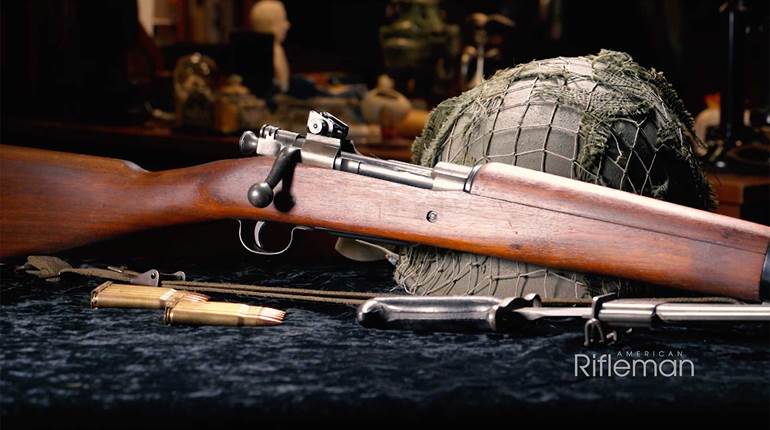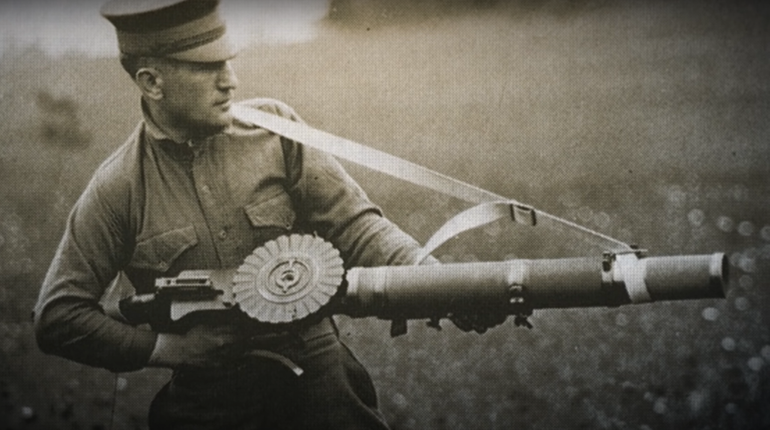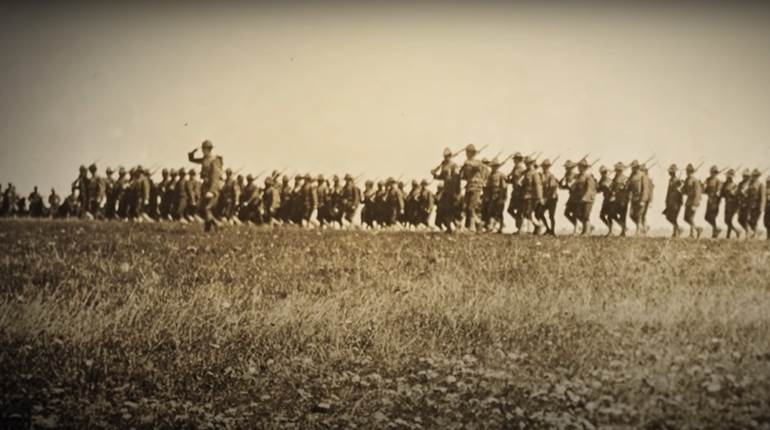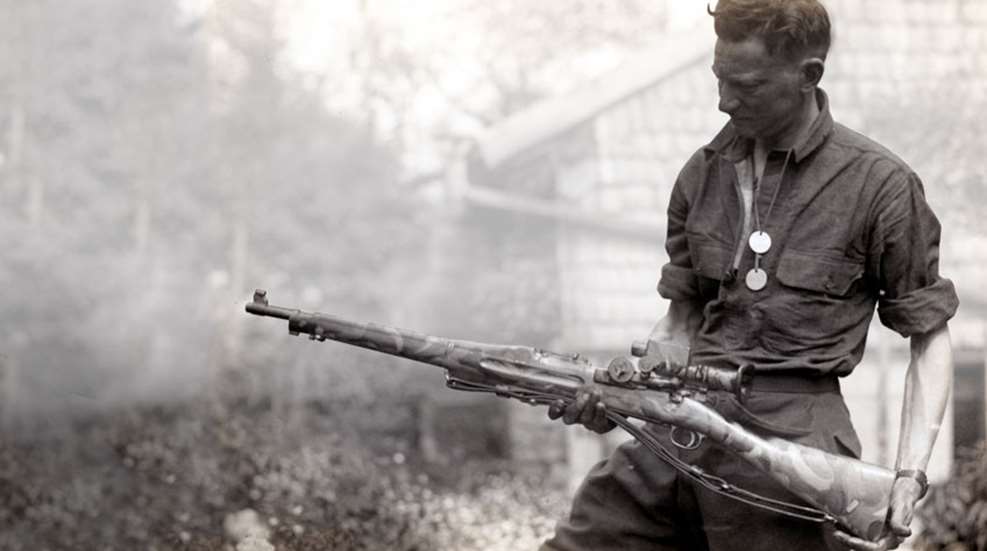
When the United States declared war on Germany in April 1917, not a single American division existed, just a regular army of 127,000 men organized as regiments. After hurried stateside training, the fall of 1918 would see 98 divisions under arms with nearly 2 million soldiers and Marines in France.
Getting there from the United States was no small accomplishment. The summer of 1917 saw 32 training camps pop up across the country, like mushrooms after a spring rain. After just 16 weeks of training, each camp shipped off a freshly trained division to France and then began training the next.
Fortunately, before being sent into combat, these newly arrived divisions had several months to train up, which included exercising the 4,000 or so soldiers and Marines who’d completed stateside sniper schools. The French commander-in-chief, Gen. Philippe Petain, applauded, “the partiality of the American soldiers for sniping,” a role, he found, “in which they easily excel.”
While their divisions conducted pre-combat training, selected soldiers were sent off to France-based British sniper schools, where they were found to be similarly proficient. The commandant of the British 1st Army Sniping, Observation and Scouting School, Maj. H.V. Hesketh-Prichard, shared Gen. Petain’s view, finding America’s hunters and riflemen, “especially right material” for the job.
For some Americans attending the British schools, this sniper training became extraordinarily realistic; when Germany launched its March 1918 Spring Offensive, the schools suspended instruction to rush instructors and students—including Americans—to help hold critical sectors. Among those unexpectedly thrust into combat was Lt. Edward Klepfer, a New York Yankee pitcher who’d earned a 1917 record of 14-4 with a 2.37 ERA in 213 innings. Klepfer, a sniper platoon leader, later wrote of his experience under enemy fire. “You know what it’s like when you’re at bat and Walter Johnson buzzes one of his fast ones past your ears?” he penned. “That’s what it feels like when the Huns are trying to pick you off.”
It appears that French units, too, received U.S. sniper support. During the first German offensive, a March 1918 stateside newspaper described a French officer pinning a Croix de Guerre to the coffin of a U.S. soldier who’d fought to the death from, “a sniper’s nest,” holding off German attackers until French reinforcements could arrive.
In The Trenches
When American divisions reached the front lines, they initially fought the same trench warfare as had been the case since late 1914. Each U.S. Army or Marine battalion included a sniper platoon within its intelligence section, led by a lieutenant or sergeant, and containing three to five sniper teams. Their missions were counter-sniping, precision shooting, scouting and observation—with special emphasis on dominating “No Man’s Land.”
Some inexperienced Doughboy snipers were eager to demonstrate their skills, which could get them into trouble. Three Alabama snipers, “went out in broad daylight to see if their new camouflage suits would camouflage,” a journalist wrote home. They nearly reached an enemy dugout before being discovered, then the Alabamans, “began firing as fast as they could load,” and quickly retreated. One sniper did not make it back. Never again would that platoon take combat so lightly.
Journalists were especially impressed by the snipers’ marksmanship. New York Sun correspondent Herman Whitaker wrote of a “Tennessee moonshiner” who “simply couldn’t stand discipline.” Officers usually looked the other way because, “He’s the finest shot we’ve got; can pick an eye out of a Boche at 300 yards.” His commander gave the Tennessean free reign anywhere along the line. “When he draws a bead on one,” an officer said, “it’s good night nurse, for he never lets loose until he’s certain.”
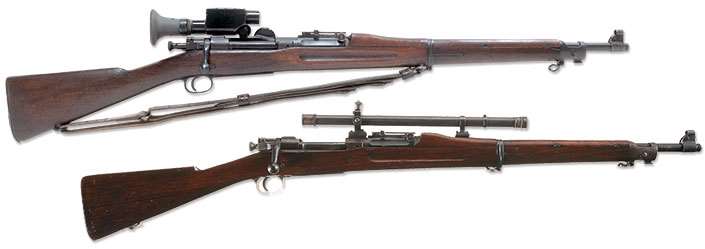
“And he’s not the only one,” a lieutenant added. “We have a dozen snipers who go out like that.”
New York Herald reporter Haywood Broun told of several U.S. Army snipers irritated to see a German soldier walking nonchalantly beyond the trenches, 1,700 yds. away, thinking himself immune from long-range fire. Knowing the odds were all but impossible to hit at such extreme range, the entire group, “agreed to count to five and fire together.” Sure enough, the snipers fired as one, and, Broun reported, “down he came.” In another case, witnessed by a Stars & Stripes reporter, three American snipers fired a precision volley to hit a German officer well beyond 1,000 yds.
Among America’s snipers, Native Americans stood out. According to Cato Sells, the U.S. Commissioner of Indian Affairs, the Germans especially feared Native American soldiers and snipers. He told Congress of a captured American officer whose interrogators asked not about his unit strength or future plans, “but on how many Indians there were” opposing them. To Sells, the American Indian made an ideal sniper because he was a “born sharpshooter, a scout by intuition and an instinctive artist in the intricacies of camouflage.”
Private Ewing Peters, a Klamath tribesman sniper, found himself entirely suited to sniping. “I felt as though I were hunting deer, only the German was the devil.” During his first of many missions he killed two such “devils.” A Literary Digest writer interviewed Silas Samuels, a Choctaw from Oklahoma and a sniper with the 312th Infantry Regiment, whose “eyes danced” as he told of one night engagement. “This Jerry was peeping over a trench one night,” his story went, “when Samuels was exploring around in a shell hole. Years of hunting deer at night gave the Indian a skill with the rifle that can be obtained in no other way, and the German ‘went West’ on one bullet.”
Out Of The Trenches, Into The Open
By mid-summer 1918, Germany’s final offensive had been repulsed and the Allies went on the offensive, beginning a new phase of maneuver called “Open Warfare.” Left behind were the tactics of trench warfare, but when it came to snipers, some commanders did not understand how to employ them effectively in this new, offensive, environment. However, other commanders appreciated their shooting and scouting abilities, and employed them to the fullest.
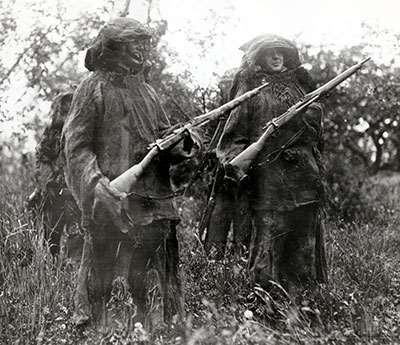
All along the Western Front, the Kaiser’s army had had more than three years to dig in, expand and improve its formidable defenses. Some positions even included concrete and steel bunkers. Anchoring these strong points were machine guns that covered approaches, flanks and obstacles, often with multiple guns integrating fire for a seemingly impenetrable defense. Entrenched infantry were arrayed to protect the machine guns.
Thus, the key to cracking German defenses was locating the machine guns and then suppressing their fire or killing their crews—an ideal mission for the keen observation and precision shooting of scout-snipers. Attesting to the courage and skill of American snipers in this role are the numerous award citations which describe their actions.
Army Cpl. George Ogden, “while acting as a battalion scout,” drove the crews from two German machine guns “by sniping,” and then, with a buddy, turned the captured guns on the enemy and defeated a counterattack. Another time, his well-aimed rifle fire forced 100 Germans to abandon a trench, allowing its capture. He was awarded the Distinguished Service Cross (DSC), our nation’s second-highest valor award.
Private Lawrence E. Caulder, a 118th Infantry Regiment sniper, and his partner “crawled through intense artillery and machine gun fire, 50 yards in advance of their platoon” to snipe enemy machine gunners who had pinned down his unit. Enemy fire killed his companion, but Caulder continued to suppress the enemy gunners until tanks arrived. He, too, received the DSC.

During the Meuse-Argonne Offensive, Sgt. James Munnell, a Minnesota Chippewa sniper, received a citation from his 1st Division commander for “fearlessly advancing alone and locating enemy machine guns that were holding up the advance of our Infantry.”
While his infantry company consolidated on a newly won position, Pvt. Ernest Morgan crawled across the open to occupy a shell crater just 50 yds. from German positions. “He remained there throughout the day without food or water and sniped at and killed ten of the enemy,” his DSC citation reports.
New York City native Cpl. John J. Finnegan earned two DSCs, “while acting as a scout and sniper.” Braving intense enemy fire, he twice crossed the Ourcq River to gather crucial intelligence. During his third one-man recon, however, Finnegan was mortally wounded.
Despite being hit twice by machine gun bullets, Cpl. Ray Sanook, a Cherokee sniper, refused medical aid until his well-aimed shots eliminated the German gun’s three-man crew. He, too, was awarded the DSC.
A battalion scout-sniper, Sgt. Victor L. Seagraves from Kansas, led a patrol against several German machine guns, “which [were] causing many casualties in his battalion.” Seagraves captured one gun, advanced alone toward another and was mortally wounded, receiving a posthumous DSC.
Another DSC recipient, Pvt. Edwin Stubbs, a sniper with the 165th Infantry Regiment, “by his skill and courage disposed of two enemy machine gunners who were causing heavy losses.” Seriously wounded by an enemy sniper, Stubbs continued to support his comrades until relieved.
Sergeant Charles Ward, an Oklahoma Cherokee, also earned a DSC. As Sgt. Ward recalled the action: “They told me there were four snipers who were playing havoc with our machine guns and that they must be brought down, and I was detailed to bring them down, and I had not more than stretched myself on the ground before the sniper … bullet struck my helmet in front and went out the back, ripped the back of my coat clear down. I had shot one sniper [300 yds.] at my left. And then ... other snipers fired and struck the side of my helmet and it went clear through and beyond me. I thought it was time to be getting out of there, and as quickly as possible I brought down both of those snipers and then the third one and was off.”
A Cumberland, Md., native, Sgt. Harry Clark, “remained by himself for two days in a sniper’s post in advance of the front line, killed 12 enemy scouts,” his DSC citation notes. He later took command when all his company officers were killed or wounded and, “steadied his men by his own coolness and courage.”
A 101st Infantry Regiment scout-sniper officer, Lt. David Hunter, “led his battalion scouts into Trugny Woods, 200 yards ahead of the assaulting waves,” his award citation reads. “Crawling to within 30 feet of an enemy machine gun nest,” Lt. Hunter, “killed or wounded every member of the crew.” He and his scouts successfully identified every gun location, enabling his unit to capture the Woods.
Lieutenant Donald S. Mackay, 168th Infantry Regiment, received the DSC for leading scouts against German machine gun positions. Severely wounded, he was credited with locating machine gun nests, “that had been stubbornly resisting,”and destroying them with artillery fire.
Another battalion scout-sniper officer, Lt. Earl W. Wall, was hit twice by machine gun fire while reconning enemy machine gun positions. He was awarded a posthumous DSC.
Second Lieutenant Blake Lightner received a Distinguished Service Cross while a sniper sergeant with the Army’s 110th Infantry Regiment. On Sept. 6, 1918, Sgt. Lightner led a daylight patrol and spotted a trench filled with enemy infantry. He shifted his snipers so they could enfilade the German trench, and then practically wiped out the occupants. “During this action,” his regimental citation notes, “Sergeant Lightner coolly stood erect and picked off the enemy as they endeavored to retreat.”
Because they fought under the U.S. Army’s 2nd Division, some Marine sniper recipients of the Navy Cross also received the Army Distinguished Service Cross for the same action. Marine Pvt. Clyde Brandon, a battalion scout with the Sixth Marine Regiment, one such sniper, employed his stalking skills and “repeatedly volunteered for hazardous reconnaissances” and “penetrating the enemy’s lines without hesitation.” He was also awarded the French Croix de Guerre.
An especially remarkable Marine sniper, Pvt. Walter Cook, 5th Marine Regiment, similarly was awarded the Navy Cross and Army DSC, plus the French Croix de Guerre with Three Palms (meaning three awards) and two Silver Stars. Scout-sniper Cook “at great danger to himself” was credited with killing 12 Germans. And then, learning that all his company officers had been killed, he took command and led his men through intense combat. Overnight he was elevated from private to gunnery sergeant.
Secretary of the Navy Josephus Daniels cited Cook and three other Marine snipers for their actions at Belleau Wood: Pvt. Edward Severance, who “performed valiant services as a sniper under constant fire;” Pvt. Earl Hoyt “displayed distinguished bravery as a sniper … inflicting severe damage to the enemy;” and Cpl. Adolph Weinberger, who, “killed an enemy sniper in a rifle duel.”
Another 5th Regiment marine sniper, Pvt. Al Barker, described how he and his teammate, Pvt. Jack Kneeland, took on machine gun crews: “I climbed a tall tree as near as possible to the German trenches and stationed myself there very comfortably. We could see the Germans setting machine guns in position to be used against our forces. We both had our rifles and plenty of ammunition, so we began to pick off the men who were operating the machine guns.”
After taking out four machine gun crews with precision rifle fire, German snipers spotted the two marines and opened fire, hitting Barker and knocking him from the tree. His teammate, Pvt. Kneeland, managed to carry him to safety despite being hit three times by German bullets. Privates Barker and Kneeland both were awarded Silver Stars.
Clearly, when correctly employed, U.S. Army and U.S. Marine Corps snipers played critical roles in the “Open Warfare” that finally brought victory to the Allies. However, fuzzy memories soon would assume World War I sniping was solely a creature of trench warfare and offered little utility for modern military operations. Snipers, sniper schools, sniper rifles and sniper doctrine virtually disappeared—until 20 years later when, at considerable human cost, they again were re-developed.
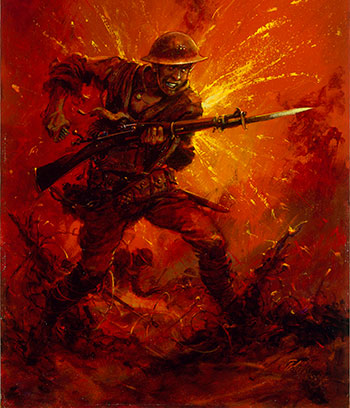 World War I Sniper Medals of Honor
World War I Sniper Medals of Honor
The first Medal of Honor ever awarded to a sniper went to U.S. Marine Cpl. John Henry Pruitt (r.), with the 78th Company, 6th Marine Regiment. While supporting an attack on Oct. 3, 1918, the young Arizonan spotted two German machine guns that were impeding his company’s advance. Pruitt took on the two guns, rushing and killing the crews with well-aimed fire and capturing both. Totally amazed, 40 enemy soldiers surrendered to the lone Marine. Afterward, Cpl. Pruitt was sniping at more Germans when an incoming shell mortally wounded him.
The war’s most remarkable one-sided engagement had to be that of U.S. Army PFC John Lewis Barkley, a 3rd Division sniper. On Oct. 7, 1918, while scouting ahead of his unit, he observed 500 to 600 Germans massing to attack across an open field. Taking cover behind a knocked-out French tank, he noticed a nearby abandoned German Maxim machine gun and a pile of ammunition belts. Setting aside his sniper rifle, Barkley dragged the Maxim into the tank and then fetched 4,000 belted rounds. Loaded and ready, he poked the Maxim muzzle through a hatch and opened fire, pouring belt after belt into the Germans, who fell in droves. So much return fire hit his tank that it sounded like a hailstorm, and then a 77 mm German shell slammed home, knocking him unconscious—but he awoke in time to engage a second wave of Germans until they abandoned the fight. Barkley was credited with single-handedly fighting off a battalion-size enemy attack.
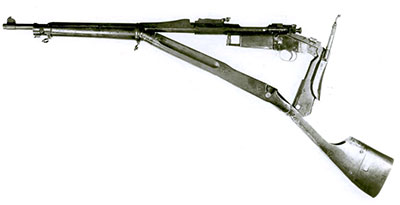 Unusual Tools of the Sniper’s Trade
Unusual Tools of the Sniper’s Trade
World War I’s protracted trench warfare saw many sniping improvisations. The most elaborate were artificial trees designed to conceal snipers and observers. An exact copy of a tree in No Man’s Land—lined with 1/2"-thick chrome-steel—was fabricated and switched at night for the real one. “A man could walk past within two feet of one,” reported Australian sniper Ian Idriess, “and not realize it was a dummy—unless he tapped it.”
Paper-mache horses and cows—similarly steel-lined—replaced carcasses in No Man’s Land, providing snipers concealment and armor protection. If detected, of course, the sniper was trapped in No Man’s Land.
Promoted with exaggerated claims, several countries developed body armor. An American inventor, Dr. Guy Brewster, offered his “Brewster Body Shield” to the Army. Although he demonstrated it could withstand a .30-’06 Sprg. bullet at 60 yds., he failed to convince the military of its utility.
For counter-sniping, the British and Americans manufactured paper-mache heads to attract enemy sniper fire. A more advanced version added a periscope to look down the tube-like bullet path through the paper-mache to discover the sniper’s hidden lair.
Another sniper’s tool was the Fixed Rifle, which used a cradle to hold a rifle firmly in place. In daylight it was carefully aimed at a spot enemy troops likely would congregate after dark. After sundown, the sniper fired his Fixed Rifle to hit enemy soldiers who’d assumed that since they couldn’t be seen, they couldn’t be shot.
Widely used were Periscope Rifles which enabled a sniper to aim and fire from a trench without exposing himself to enemy fire. The shooter manipulated a rod or cord to pull the trigger on his frame-mounted rifle.
The U.S. Ordnance Dept. developed the Elder Periscopic Attachment, Model of 1918, for M1903 Springfield and M1917 Enfield rifles. Also a unique 1903 Springfield stock (above) was built; by pushing a button, the soldier pivoted the stock open, scissors-like, and locked it into place 35 degrees below the receiver and aimed via an Elder Periscope. Neither device reached France before the Armistice.
Although useful during trench warfare, once the Allied armies left the trenches and maneuvered on open ground, these clever improvisations became obsolete.
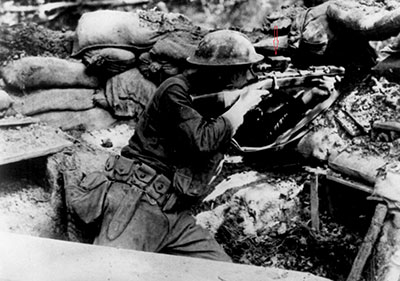 Sniping In The Trenches
Sniping In The Trenches
Major John L. Plaster, U.S. Army (Ret.), is the author of The Ultimate Sniper as well as The History Of Sniping And Sharpshooting, the latter being, hands down, the finest and most comprehensive work on the subject to date. But Maj. Plaster has continued to find more information on snipers and sniping since the latter was published. The result was Sniping In The Trenches: World War I And The Birth Of Modern Sniping, covering the rifles, optics and ammunition, plus the training and tactics used by both the Allies and the Germans during the Great War.
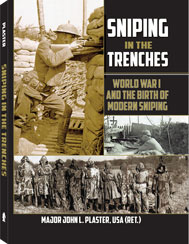 From France and Flanders to Gallipoli and the Meuse-Argonne Offensive, there is detailed information on men—the snipers themselves—that has not been reported on in decades, and certainly not in one volume. Too, firsthand accounts are included from American, British and Canadian snipers. The 81/2"x11" hardbound, 280-pp. book contains nearly 500 photos and is available from ultimatesniper.com. The price is $40 plus shipping.
From France and Flanders to Gallipoli and the Meuse-Argonne Offensive, there is detailed information on men—the snipers themselves—that has not been reported on in decades, and certainly not in one volume. Too, firsthand accounts are included from American, British and Canadian snipers. The 81/2"x11" hardbound, 280-pp. book contains nearly 500 photos and is available from ultimatesniper.com. The price is $40 plus shipping.
—Mark. A. Keefe, IV, Editor In Chief












